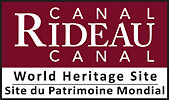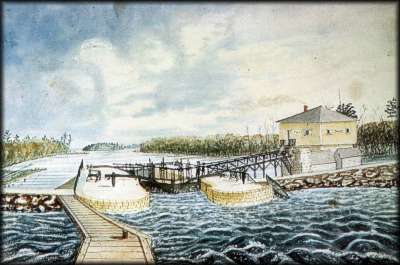


 |  |  |
| Explore the Rideau Canal and Friends of the Rideau by following these links: |
The Rideau Canal, which opened for navigation in 1832, is the oldest continuously operated canal system in North America still in its original form. In 1826, Lt. Colonel John By of the British Royal Engineers was assigned to create a navigable waterway from Kingston to Ottawa through a wilderness of rough bush, swamps, and rocky terrain. It was built for military purposes, to ensure a safe supply water route to Kingston in event of another war with the United States. The need for this came up during the War of 1812 (which ended in 1814), where we beat back the invading Americans. That war showed that the St. Lawrence River was very vulnerable to American attack, this was a safe backdoor route from Montreal to Kingston, via the Ottawa River and the Rideau Canal. While a bit of work at Ottawa was done in the fall of 1826, the main work on building the Rideau Canal started in 1827. It was built all at once, Colonel By divided the work into 23 sections with a contractor for each section. Five years later, in the spring of 1832, one of the greatest engineering feats of the 19th century was complete with the first steamboat transit done with Colonel By and his family on board in May, 1832. The Rideau Canal is one of North America's most beautiful navigable waterways, with exquisite stonemasonry admired to this day. The canal was designed by Lt. Colonel John By and built, for the most part, by independent contractors under the supervision of Colonel By and his staff of Royal Engineers. The work was done by hand with the aid of few draft animals. Hundreds of Irish and French Canadian labourers, Scottish and French-Canadian stonemasons, tradesmen such as masons, blacksmiths and carpenters, and British Sappers & Miners battled the Canadian wilderness, nineteenth century working conditions, malaria (temperate malaria - endemic at that time to southern Ontario, including the southern part of the Rideau) and other diseases to complete this wonder of a canal system in less than six years. It is guesstimated that about 1,000 men and family members died during construction, about half of those from malaria, the other half from other diseases and work related accidents. Accidents were actually low for a project of this magnitude in that era, it was disease that took the greatest (90%+) toll. The canal was built as a slackwater canal, using dams to raise water levels to flood or bypass rapids rather than doing canal cuts and tow paths as was the canal convention of the era. Colonel By saw that steamboats (self propelled boats) were the future which allowed him to use the faster and less expensive slackwater technique. The extensive use of this engineering technique is one of the reasons for the current World Heritage Site status of the Rideau Canal. The Rideau Canal is a series of lakes and river, connected by locks and few canal cuts. Only about 10% of the 202 km distance consists of excavated channels. Even in the Ottawa section, almost 40% of the distance from Hogs Back to the Ottawa locks used slackwater rather than excavations. The dams include the beautiful arched dam at Jones Falls and the four locks (three locks, a turning basin, and a fourth lock, with a total lift of 60 feet ) making Jones Falls one of the engineering triumphs of the Rideau Canal. The arch dam was one of the first of its kind. Spanning 350 feet and rising 60 feet, it was the largest such structure in North America. One of the jewels of the Rideau, Jones Falls is a "must see" for visitors.  Narrows Lock and Blockhouse - 1841 If you've heard of the Battle of Waterloo, then you remember the Duke of Wellington. After the War of 1812, he laid out a defense strategy for Upper Canada. Forts, towers, blockhouses, navigable waterways, and settlements of trained, loyal settlers were the key elements of this strategy. Perth, established in 1816, was one of the first such settlements. A brief journey to Perth up the Tay Canal starts at Beveridge Lock, on Lower Rideau Lake. Perth was the social, judicial and administrative centre for the Rideau Corridor away from the border with the U.S. Large, elegant homes of brick and stone, built for military officers, hosted genteel dinner parties - but guests had to bring their own chairs. Upper Canada's Last Fatal Duel, fought by two law students, Robert Lyon and John Wilson, over the honour of a local belle, took place in Perth on June 13, 1833. Mr. Lyon was on the losing end of the exchange. See The Last Duel in Upper Canada (external website) The original road from Brockville to Perth, crossed Rideau Lake at Oliver's Ferry (now known as Rideau Ferry). The ferry crossing was named after a man named Oliver who set up a ferry to take people across this narrow spot in the lake. A tale is told that Mr. Oliver had an unusual habit of refusing to transport passengers after dark, instead he would put them up in his house. His neighbours though, seldom saw the travellers in the morning. Several travellers did not make their destination and it was assumed at the time that they were victims of highway robbers. Many years later, when a bridge was built to replace the ferry, Oliver's house had to be torn down. It is said that in the walls and under the floorboards of additions Oliver had made to the original house, human skeletons were found. It seems that many of Oliver's late night guests never left. While that tale is fiction, Mr. Oliver did meet with a rather abrupt end, shot through the heart by a neighbour in a dispute over trespassing cows. See Skeletons Under the Floor (external website).
By the 1950s, the Rideau became the waterway that visitors enjoy today, a recreational paradise. Cottages dot the shorelines and boats of all sizes cruise the lakes and canals. The Rideau Canal System is run by Parks Canada, who maintain the original spirit, even operating the locks by hand. A tour of the Rideau Canal system is a must. Learn More Rideau History: The Books Section of our website lists several books that are still in print or available as a PDF detailing the fascinating history of the Rideau Canal. Visit the History section of www.rideau-info.com for all sorts of Rideau history. Those interested in detailed research history of the Rideau Canal may wish to look at the detailed research reports we've digitized as part of our Resources of the Rideau project. These and other digitized Rideau research reports as free PDF downloads from our Rideau Manuscript Report Page P.O. Box 1232, Stn. Main Smiths Falls, Ontario, Canada, K7A 5C7 email: info@rideaufriends.com
Comments about the website email: info@rideaufriends.com |